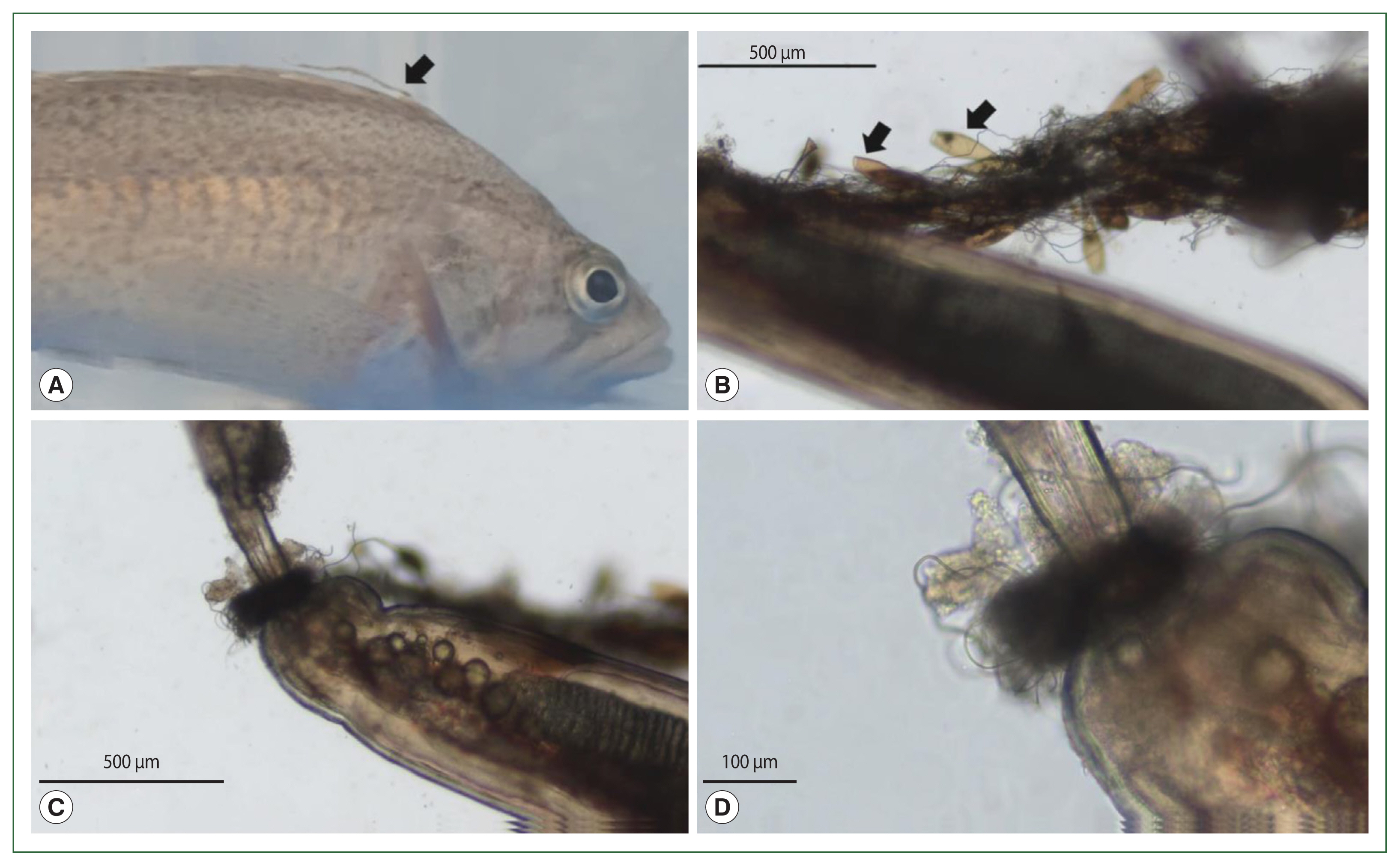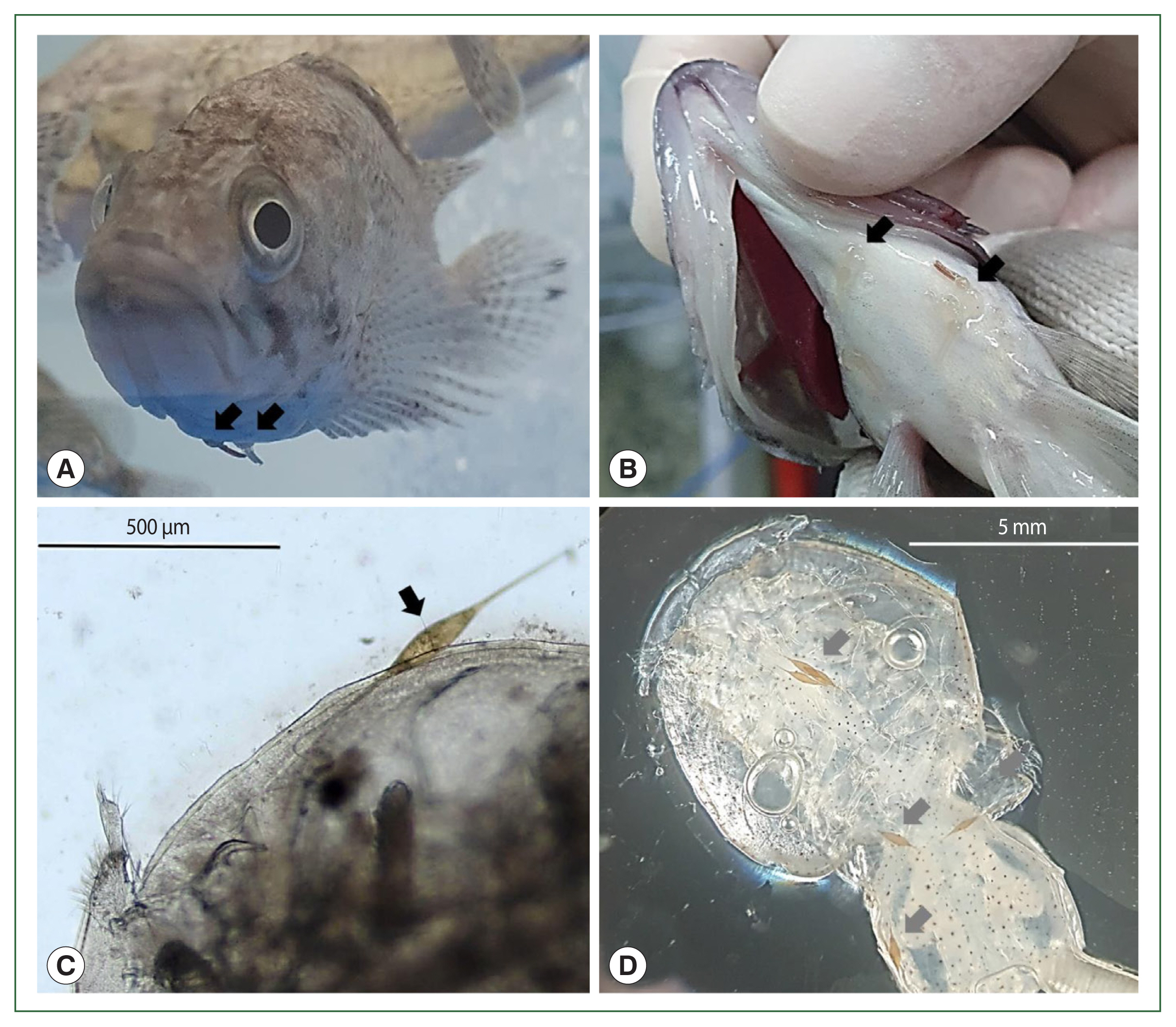In Korea, as well as in globe, aquaculture plays a significant role in the production of food. Numerous climatic, environmental, and infectious conditions continuously pose a hazard to fish aquaculture [1]. Parasite infections are one of the pathogenic causes that seriously endanger the aquaculture sector in Korea. A particularly destructive parasite that attacks the Korean rockfish Sebastes schlegelii is a monogenean trematode called Microcotyle sebastis [2,3]. Additionally, owing to their high rates of infection, parasitic copepods like Lepeophtheirus sp. and Peniculus sp. are regarded as potentially hazardous [4,5]. It is crucial to increase our knowledge of how parasites impact Korean rockfish.
The body surface of marine fish is regularly infested with monogenean trematodes and parasitic copepods. Both animal groups have direct life cycles, with larvae (early developmental stages) that may live freely and parasitic juveniles and adults. Most monogeneans lay eggs that hatch into oncomiracidia, larvae that cling to certain host species [6]. Some species are viviparous, meaning they produce young parasites that attach to the same host as their parents and may subsequently transfer to a new host with whom they come into contact [7]. Monogeneans, particularly gill flukes, repeatedly irritate the gills, creating inflammation, and they feed on the blood, mucus, and tissues of the host fish, resulting in growth failure and final death [8]. Infection with parasitic copepods causes inflammation or bleeding at the attachment site, culminating in necrosis [9]. These symptoms are serious since they may be the primary cause of subsequent wound infection and reduced immunity, which can lead to mortality.
Previous research on monogenean and parasitic copepods concentrated on the geographic distribution of parasite species, simultaneous quarantine, the effect of contaminated water temperature, and interspecies competition [10–12]. Despite this, there has been little published study on how monogeneans and parasitic copepods interact given their varied environments. Thus, the purpose of this study was to determine the endemicity of a monogenean trematode (M. sebastis) and 2 parasitic copepod species (Lepeophtheirus elegans and Peniculus truncates) in Korean rockfish (Sebastes schlegelii) from a fish farm in Tongyeong-si, Gyeongsangnam-do, Korea.
In this study, we looked at 120 Korean rockfish from a fish farm, each weighing an average of 28.8 g. Each individual fish was thoroughly inspected using an inverted microscope, ECLIPSE Ts2 (Nikon, Tokyo, Japan), to detect and evaluate the presence of monogenean parasites and parasitic copepods. Extracted gills from Korean rockfish were cleaned in phosphate-buffered saline and counted using an inverted microscope. Parasitic copepods were counted when they were detached from the corpse using tweezers and then examined under an inverted microscope in a 90×15 mm Petri dish filled with sterile saltwater.
In this study, the infection rates for M. sebastis and parasitic copepods were 98.4% and 91.7%, respectively, with a concurrent infection rate of 90.8%. The mean infection intensity of M. sebastis was 7±5.4 per fish, and for parasitic copepods, it was 4±3.1 per fish. Identification of M. sebastis was achieved using a combination of molecular analysis, including PCR and sequencing methodologies, as well as morphological analysis, as previously described (Fig. 1A) [13]. Parasitic copepods were discovered on the Korean rockfish’s fins and ventral area. Forceps were used to retrieve them, which were then stored in formalin. The exterior morphology was identified using an inverted microscope (Fig. 1B, C). As a result, the parasites were identified as Lepeophtheirus elegans and Peniculus truncatus, both of which have previously been reported to infect Korean rockfish [14,15]. In addition to the parasite body and eggshell, a 2 cm long brown thread was found attached to the top fins of Korean rockfish by P. truncatus (Fig. 2A). Furthermore, microscopic inspections revealed a cluster of monogenean eggs (Fig. 2B) and confirmed that the filaments of the monogenean eggs overlapped were anchored to the curved zone between the neck and body of P. truncatus (Fig. 2C, D). Lepeophtheirus elegans was found between the head and the pectoral region of rockfish (Fig. 3A, B). A microscopic examination revealed that, like P. truncatus, monogenean eggs were linked to the body of L. elegans (Fig. 3C, D).
Up to 87.0% of Korean rockfish with an average length of 11–15 cm were found in prior investigations, among which 79.6% of those fish had parasitic illnesses [3]. These data, together with ours, demonstrate that parasitic illnesses are consistently present in farmed rockfish. Monogenean eggs have a life cycle that includes detaching from the gills, swimming through water, attaching to different substrates, hatching, and returning to the host at some point [16]. In the wild, eggs often adhere to things like rocks or seaweed, but in cage farming, the eggs typically cling to farm netting [17]. Additionally, this study’s findings revealed that monogenean eggs were linked to parasitic copepods. This shows that by sticking to P. truncatus and L. elegans, M. sebastis eggs in Korean rockfish may spread to other individuals within the host species. However, unlike Udonella sp., a monogenean species that coexists symbiotically with the parasitic copepod Caligus sp., M. sebastis does not develop an adult attachment to parasite copepods [18].
Monogenean eggs are endowed with filaments containing adhesive components that facilitate attachment to substrates, and egg strings can form when the environment promotes continuous interaction between these eggs [19]. Produced in the gills, M. sebastis eggs are incapable of adhering to fish bodies coated with scales and mucous while floating in seawater. However, the parasitic copepods P. truncatus and L. elegans that attach to the exposed appendages and thorax lack secretions. Therefore, the filaments of M. sebastis embryos are able to adhere to the bodies of copepods. Once affixed, the embryos undulate like threads in a setting that promotes long-term adhesion. The adhesive filaments unite and strengthen over time. P. truncatus persistently collects egg threads for as long as it can withstand the weight.
Copepods are not only directly affected by pathogens, but they also serve as mechanical and biological vectors, reservoirs, and alternative hosts for a wide range of pathogens, many of which are of commercial significance. Specifically, parasitic copepods, particularly those belonging to the genera Caligus, Lepeophtheirus, and Ergasilus, are known or suspected to serve as vectors for bacterial and viral transmission among fish species [20]. The fish-pathogenic protist Neoparamoeba perurans can also be transmitted by L. salmonis [21]. In addition, Marteilia refringens, a parasite of the oyster Ostrea edulis, can be introduced to bivalve hosts by Paracartia grani and possibly P. latisetiasa [22]. As a result, the observed relationship between M. sebastis and parasitic copepods does not represent an evolved symbiotic association comparable to that of Udonella sp. It facilitates the development of M. sebastis embryos in close proximity to their host, the Korean rockfish, rather than in more remote locations, such as an existing farm net or another natural object. Our findings imply a novel vector in which egg can be transmitted within a single adult host (Figs. 2, 3), thereby potentially increasing the risk of infection and influencing its prevalence in the Korean rockfish population. Although additional research is necessary to confirm whether parasitic copepods affect the infection rate of M. sebastis, we have identified the possibility of concurrent external double infections.
The most important finding of this study is the potential association between monogeneans (M. sebastis) and parasitic copepods (L. elegans and P. truncatus) in populations of Korean rockfish (S. schlegelii). Observations revealed that M. sebastis eggs were affixed to parasitic copepods on the host fish, indicating that these copepods may indirectly contribute to the increased infection rate and risk of M. sebastis in the host community as they migrate together. This relationship may have an impact on the health and well-being of the Korean rockfish population and the aquaculture industry in Korea.
Nevertheless, this research has some limitations. First, the sample size is relatively small (120 Korean rockfish), which may not be representative of the population as a whole. In addition, the study concentrates predominantly on the observation of the attachment of M. sebastis egg to parasitic copepods but does not investigate the potential effects of this relationship on the host fish’s overall health and survival. In addition, additional research is required to comprehend the increasing infection rate and injury caused by copepods to Korean rockfish and to determine the extent to which this relationship influences the infection rate of M. sebastis.
In conclusion, this study investigated the relationship between monogeneans and parasitic copepods in the population of Korean rockfish. As the host moves, it is possible that the attachment of M. sebastis egg to parasitic copepods on the host could increase the infection rate within the host community. Our findings suggest that parasitic copepod infections may influence the prevalence of M. sebastis, though additional research is necessary. This provides important information for the effective management of farmed Korean rockfish populations.









